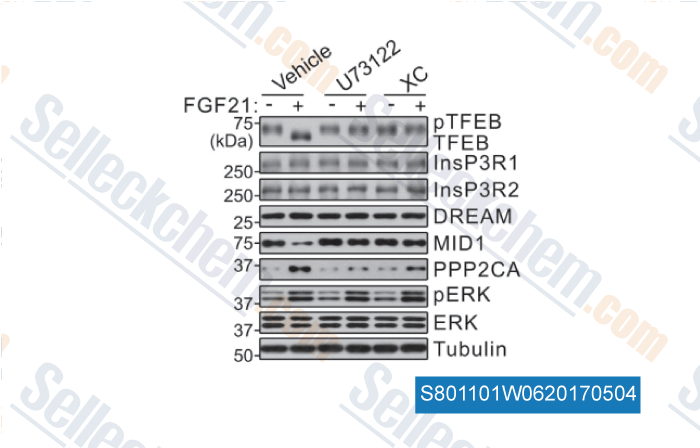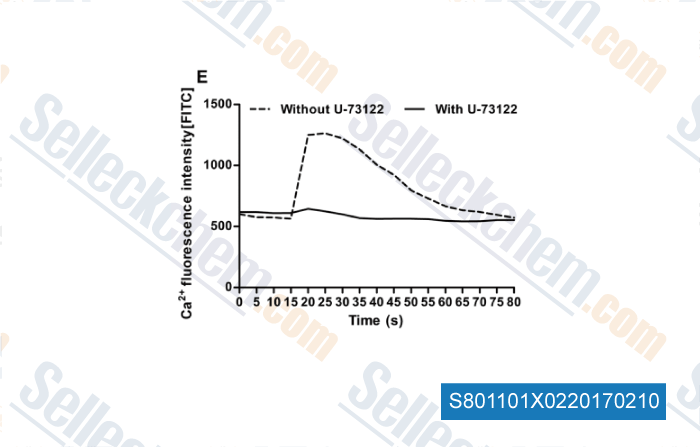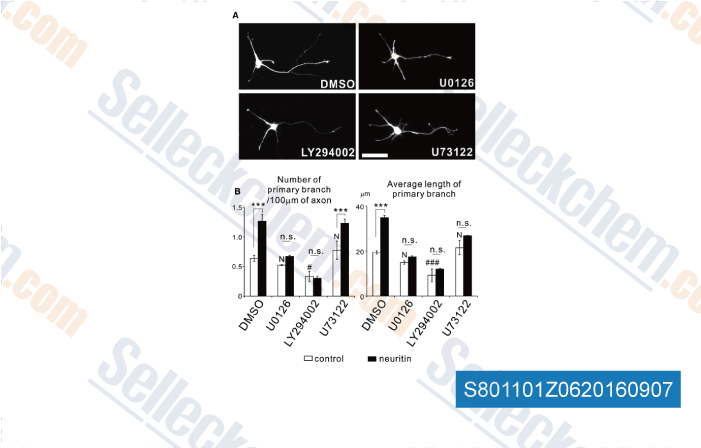|
Toll Free: (877) 796-6397 -- USA and Canada only -- |
Fax: +1-832-582-8590 Orders: +1-832-582-8158 |
Tech Support: +1-832-582-8158 Ext:3 Please provide your Order Number in the email. |
Technical Data
| Formula | C29H40N2O3 |
||||||
| Molecular Weight | 464.64 | CAS No. | 112648-68-7 | ||||
| Solubility (25°C)* | In vitro | DMF (warmed with 50ºC water bath) | 24 mg/mL (51.65 mM) | ||||
| DMSO | 0.01 mg/mL (0.02 mM) | ||||||
| Water | Insoluble | ||||||
| In vivo (Add solvents to the product individually and in order) |
|
||||||
|
* <1 mg/ml means slightly soluble or insoluble. * Please note that Selleck tests the solubility of all compounds in-house, and the actual solubility may differ slightly from published values. This is normal and is due to slight batch-to-batch variations. * Room temperature shipping (Stability testing shows this product can be shipped without any cooling measures.) |
|||||||
Preparing Stock Solutions
Biological Activity
| Description | U73122 is a potent phospholipase C (PLC) inhibitor, which reduces agonist-induced Ca2+ increases in platelets and PMN. U73122 potently inhibits human 5-lipoxygenase (5-LO). | |
|---|---|---|
| Targets |
|
|
| In vitro | U73122 significantly inhibits aggregation of human platelets induced by a variety of agonists, including collagen, thrombin, ADP, arachidonic acid, with IC50 of 1-5 μM. U-73122 (10 μM) inhibits the production of IP3 and the subsequent rapid increase in cytosolic Ca2+ induced by either thrombin or U-46619 through inhibiting hydrolysis of phosphatidyl[3H]inositol and phosphatldyl[3H]inosito1 4,5-bisphosphate catalyzed by a soluble fraction from platelets (Ki=9 and 40 μM, respectively). U-73122 inhibits thromboxane B production induced by collagen through inhibiting receptor-coupled mobilization of arachidonic acid. U73122 inhibits also FMLP-induced aggregation of human polymorphonuclear neutrophils and the associated production of IP3 and diacylglycerol. [1] U-73122 causes a concentration-dependent inhibition of C5a, FMLP, PAF and LTB4-induced MPO and B12-BP release from cyto-chalasin B-treated PMNs. The IC50 values are 60 (FMLP), 110 (LTB4), 115 (C5a) and 120 (PAF) nM for MPO release; and 105 (FMLP), 110 (LTB4), 120 (C5a) and 140 (PAY) nM for B12-BP release. U-73122 is also a potent inhibitor of superoxide anion production by cytochalasin B-treated PMNs activated with either C5a or FMLP with IC50 of 160 and 300 nM, respectively. U-73122 causes suppression of the rise in [Ca2+]i, IP3 production and DAG production in FMLP-stimulated PMNs with IC50 of 500 nM, 2 μM, and 2 μM, respectively. 3 μM U-73122 causes 100% inhibition of FMLP-induced GTPase activity. U-73122 causes a concentration-dependent inhibition of the FMLP-evoked association of PKC with the extractable particulate fraction of PMNs, but not a soluble preparation of PMN PKC. [2] U73122 significantly inhibits recombinant human PLC-β2, with an IC50 of ~6 μM. U73122 has little effect on PLC-β1, PLC-β3, or PLC-β4. U73122 reduces interleukin-8 and leukotriene B4-induced Ca2+ flux and chemotaxis in human neutrophils with IC50 of ~6 μM and ~5 μM, respectively. [3] 1 μM U73122 blocks bradykinin (BK)-induced increases in the intracellular free Ca2+ concentration in undifferentiated NG108-15 cell. The IC50 for a 20-min exposure is approximately 200 nM. 1 μM U73122 produces a small but significant increase in [Ca2+]i which results from Ca 2+ release from an intracellular store. In differentiated NG108-15 cells U73122 blocks completely depolarization-induced Ca2+ influx. In contrast, in DRG neurons U73122 inhibits only slightly voltage-sensitive Ca2+ channels. [4] U73122 is a relatively specific inhibitor of G-protein-mediated phospholipase C activation in pancreatic acini. U73122 inhibits phosphatidylinositol (PI) hydrolysis on stimulation with either cholecystokinin (by 81%) or carbachol (by 73%) at a maximal effect concentration of 10 μM. U73122 (10 μM) inhibits the increases in [Ca2+]i stimulated by high concentrations of secretagogues in fura-2-loaded acini. U73122 also inhibits the [Ca2+]i signal generated by directly stimulating G-proteins with sodium fluoride. U73122 rapidly inhibits the oscillating [Ca2+]i signal elicited by low concentrations of cholecystokinin or carbachol. [5] U73122 increases the activity of hPLCβ3 in a concentration-and time-dependent manner in a cell-free micellar system, with up to an 8-fold increase in enzyme activity and a EC50 of 13.6 μM. Activation of hPLCβ3 by U73122 requires covalent modification of cysteines. U73122 (10 μM) also activates hPLCγ1(>10-fold) and hPLCβ2(~2-fold); PLC δ1 is neither activated nor inhibited. [6] |
|
| In vivo | U73122 (30 mg/kg i.p.) blocks swelling of rats hind paw by 65 and 80% at 1 and 3 h postcarrageenan challenge. U73122 (0.1 mg/mL) inhibits carrageenan-induced macrophage and lymphocyte accumulation into subcutaneous chambers in dogs by 65 and 74%, respectively. U73122 (30 mg/kg i.p.) totally inhibits the LPS-induced increase in macrophage and lymphocyte infiltration and prostaglandin E2 production (by 80%) in a mouse peritonitis model, and inhibits and 12- O-tetradecanoyl-phorbol-13-acetate-induced ear edema in mice. [3] |
Protocol (from reference)
| Kinase Assay: |
|
|---|---|
| Animal Study: |
|
References
Customer Product Validation

-
, , Cell Res, 2017, 27(6):748-763

-
, , Virus Genes, 2016, 53(2):179-189

-
Data from [Data independently produced by , , J Neurosci, 2016, 36(16):4534-48.]

-
Data from [Data independently produced by , , Cell Physiol Biochem, 2018, 51(2):647-663]
Selleck's U73122 has been cited by 72 publications
| Kisspeptin-10 binding to Gpr54 in osteoclasts prevents bone loss by activating Dusp18-mediated dephosphorylation of Src [ Nat Commun, 2024, 15(1):1300] | PubMed: 38346942 |
| Impaired degradation of PLCG1 by chaperone-mediated autophagy promotes cellular senescence and intervertebral disc degeneration [ Autophagy, 2024, 10.1080/15548627.2024.2395797] | PubMed: 39212196 |
| Bactericidal/permeability-increasing protein instructs dendritic cells to elicit Th22 cell response [ Cell Rep, 2024, 43(3):113929] | PubMed: 38457343 |
| Cell-cell interaction determines cell fate of mesoderm-derived cell in tongue development through Hh signaling [ Elife, 2024, 13e85042] | PubMed: 39392396 |
| U-73122, a phospholipase C inhibitor, impairs lymphocytic choriomeningitis virus virion infectivity [ J Gen Virol, 2024, 105(12)002060] | PubMed: 39688895 |
| Microbial metabolite butyrate promotes anti-PD-1 antitumor efficacy by modulating T cell receptor signaling of cytotoxic CD8 T cell [ Gut Microbes, 2023, 15(2):2249143] | PubMed: 37635362 |
| Microbial metabolite butyrate promotes anti-PD-1 antitumor efficacy by modulating T cell receptor signaling of cytotoxic CD8 T cell [ Gut Microbes, 2023, 15(2):2249143] | PubMed: 37635362 |
| Inhibiting the glycerophosphodiesterase EDI3 in ER-HER2+ breast cancer cells resistant to HER2-targeted therapy reduces viability and tumour growth [ J Exp Clin Cancer Res, 2023, 42(1):25] | PubMed: 36670508 |
| PDE4DIP contributes to colorectal cancer growth and chemoresistance through modulation of the NF1/RAS signaling axis [ Cell Death Dis, 2023, 14(6):373] | PubMed: 37355626 |
| PDE4DIP contributes to colorectal cancer growth and chemoresistance through modulation of the NF1/RAS signaling axis [ Cell Death Dis, 2023, 14(6):373] | PubMed: 37355626 |
RETURN POLICY
Selleck Chemical’s Unconditional Return Policy ensures a smooth online shopping experience for our customers. If you are in any way unsatisfied with your purchase, you may return any item(s) within 7 days of receiving it. In the event of product quality issues, either protocol related or product related problems, you may return any item(s) within 365 days from the original purchase date. Please follow the instructions below when returning products.
SHIPPING AND STORAGE
Selleck products are transported at room temperature. If you receive the product at room temperature, please rest assured, the Selleck Quality Inspection Department has conducted experiments to verify that the normal temperature placement of one month will not affect the biological activity of powder products. After collecting, please store the product according to the requirements described in the datasheet. Most Selleck products are stable under the recommended conditions.
NOT FOR HUMAN, VETERINARY DIAGNOSTIC OR THERAPEUTIC USE.
